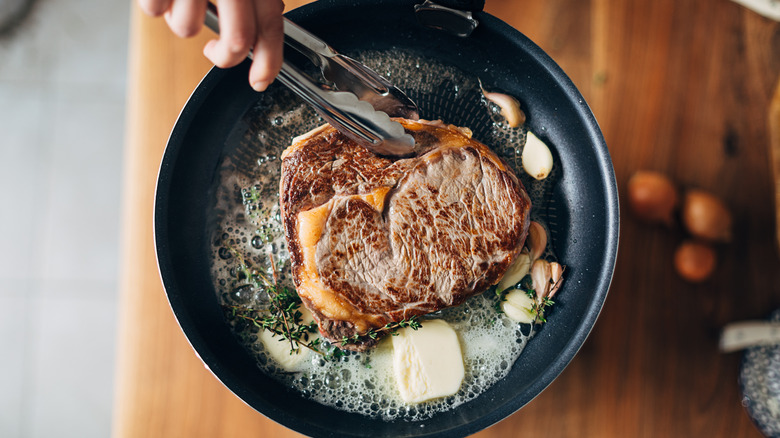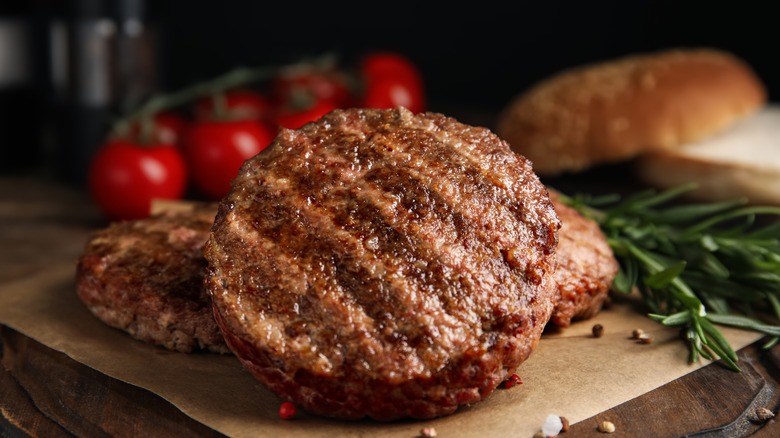Why Bobby Flay Prefers His Steaks And Burgers Cooked Medium
How you like your steak cooked can sometimes be a source of controversy. While it is possible to order well-done steak without breaking your server's heart, perhaps with a little polite explanation of your preference, it can also be accompanied by the sinking feeling that you're not eating the meat the way it's 'supposed' to be cooked. After all, most professional chefs and steak aficionados would surely almost always advise medium-rare or even rare.
Or would they? Because Bobby Flay begs to differ. When it comes to both steaks and burgers, the restaurateur and "Beat Bobby Flay" star prefers his meat cooked medium. And he admitted on Instagram that although it might seem a surprising choice, a lot of his chef friends actually tend to agree with him.
The reason, Flay believes, is because the brief extra cooking time required for a medium result improves both the taste and the texture of the beef. Rare steak can sometimes be harder to chew, which makes it a less enjoyable experience for the chef. But it also comes down to the fat content of steaks and burgers. Giving the fat the opportunity to melt into the meat gives it a better flavor for Flay — while still keeping the finished steak or homemade all-American cheeseburger pink and juicy.
Bobby Flay likes beef fat to melt for richer flavor
So what does medium actually mean? The internal temperature for a medium steak is between 140 to 150 degrees Fahrenheit, which is not far off the USDA's recommendation to cook beef to a minimum of 145 degrees. If you cut into a medium steak, you'd see a center that has some pink but no red, and is warm rather than cool. For Bobby Flay, medium also means a more succulent and tasty result, thanks to rendered fat.
When it comes to choosing the perfect steak at the store, chances are you look for marbling in the meat. Burgers, too, need a good proportion of fat; ground chuck with 20% fat is Flay's ideal blend. Fat adds extra rich flavor to both steaks and burgers. But to get the full impact, you need it to melt into the meat, which it doesn't have the time to do if they're cooked rare. The fat also helps keep the beef juicy, and stops it from drying out as it cooks; as Flay puts it, it "lubricates" the meat (via Instagram).
While it is possible to cook homemade burgers to medium (140 to 145 degrees Fahrenheit) when you've freshly ground the meat yourself, store-bought ground beef should be cooked to 160 Fahrenheit to guarantee a safe result (per the CDC). The USDA also recommends that minimum internal temperature to destroy any potentially harmful bacteria that may be mixed through the ground meat.
How to ensure medium steaks and burgers stay juicy
If you've ever cooked a steak or burger to the required medium temperature, patiently let it rest, and then cut into it to find it's disappointingly overcooked, you're not alone. The reason is that meat carries on cooking as it's resting. Taking beef off the heat early is one of the ways Bobby Flay cooks a juicy steak every time; to replicate the technique, remove steaks and burgers from the pan or grill when they are 5 degrees below your ideal final temperature.
While there are hacks to tell when steak is perfectly cooked, the best way to accurately measure the temperature is to use a meat thermometer. Stick the probe into the center of the steak where it is thickest — and do not worry about taking the temperature at regular intervals, as the meat will not lose any juiciness from repeated probing. With burgers, stick it into the center of the thickest patty, or if your burgers are thin, you can push the thermometer horizontally from one side into the middle.
While different steaks suit different servings, medium is ideal for some tougher cuts such as hangar, tri-tip, or flank. The extra time also benefits some fattier cuts and is a good choice for sharing steaks if both parties prefer different levels of doneness. But if you genuinely just prefer steaks and burgers medium rather than rare, you're in good company with Bobby Flay.



